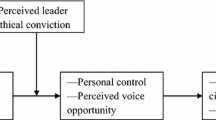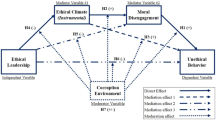Abstract
This article contributes to our understanding of how communication of ethical guidelines by managers may reduce the likelihood of employee unethical behavior. We conduct two vignette experiments to assess the impact of communicating two types of ethical guidelines—general and specific. The second study employs mixed methods experimental design, collecting qualitative data during the experiment. We find that communicating ethical guidelines by managers reduces the likelihood of unethical behavior, but contrary to our hypothesis and prior literature, we observe that general ethical guidelines are more effective than specific ethical guidelines. We conduct thematic coding of open-ended qualitative responses and integrate the findings of qualitative analysis with the quantitative analyses to provide insights into the counter-hypothetical finding. With specific guidelines, we observe that participants use specific details to negate or rationalize ethical concerns, and with general guidelines, participants recognize ethical concerns and are less likely to downplay them. We conclude by discussing the implications of these findings for research on ethical leadership.
Similar content being viewed by others
References
Ashkanasy, N. M., Falkus, V. S., & Callan, V. J. (2001). Predictors of ethical code use and ethical tolerance in the public sector. Journal of Business Ethics, 25, 237–253.
Bandura, A. (1999). Moral disengagement in the perpetration of inhumanities. Personality and Social Psychology Review, 3, 193–209.
Bandura, A., Barbaranelli, C., Caprara, G. V., & Pastorelli, C. (1996). Mechanisms of moral disengagement in the exercise of moral agency. Journal of Personality and Social Psychology, 71, 364–374.
Bedi, A., Alpaslan, C. M., & Green, S. (2016). A meta-analytic review of ethical leadership outcomes and moderators. Journal of Business Ethics, 139, 517–536.
Berson, Y., Halevy, N., Shamir, B., & Erez, M. (2015). Leading from different psychological distances: A construal-level perspective on vision communication, goal setting, and follower motivation. The Leadership Quarterly, 26, 143–155.
Brown, M. E., Treviño, L. K., & Harrison, D. A. (2005). Ethical leadership: A Social learning perspective for construct development and testing. Organizational Behavior and Human Decision Processes, 97, 117–134.
Bums, J. M. (1978). Leadership. New York: Harper & Row.
Chung, A., & Rimal, R. N. (2016). Social norms: A review. Review of Communication Research, 4, 1–28.
Cialdini, R. B., & Goldstein, N. J. (2004). Social influence: Compliance and conformity. Annual Review of Psychology, 55, 591–621.
Cialdini, R. B., Reno, R. R., & Kallgren, C. A. (1990). A focus theory of normative conduct: Recycling the concept of norms to reduce littering in public places. Journal of Personality and Social Psychology, 58, 1015–1026.
Ciulla, J. B. (1995). Leadership ethics: Mapping the territory. The Business Ethics Quarterly, 5(1), 5–24.
Collett, J. L., & Childs, E. (2011). Minding the gap: Meaning, affect, and the potential shortcomings of vignettes. Social Science Research, 40(2), 513–522.
Creswell, J. W., & Plano Clark, V. L. (2018). Designing and conducting mixed methods research (3rd ed.). Thousand Oaks, CA: Sage Publications.
Detert, J. R., Treviño, L. K., & Sweitzer, V. L. (2008). Moral disengagement in ethical decision making: A study of antecedents and outcomes. Journal of Applied Psychology, 93, 374–391.
Downe, J., Cowell, R., & Morgan, K. (2016). What determines ethical behavior in public organizations: Is it rules and/or leadership. Public Administration Review, 76, 898–909.
Fehr, R., Yam, K.C., & Dang, C. (2015). Moralized leadership: The construction and consequences of ethical leader perceptions. Academy of Management Review, 40(2), 182–209.
Feldman, D. C. (1984). The development and enforcement of group norms. Academy of Management Review, 9, 47–55.
Gino, F., & Margolis, J. D. (2011). Bringing ethics into focus: How regulatory focus and risk preferences influence (un)ethical behavior. Organizational Behavior and Human Decision Processes, 115, 145–156.
Graen, G. B. (1976). Role making processes within complex organizations. In M. D. Dunnette (Ed.), Handbook of industrial and organizational psychology (pp. 1201–1245). Chicago: Rand-McNally.
Graham, J., Haidt, J., & Nosek, B. A. (2009). Liberals and conservatives use different sets of moral foundations. Journal of Personality and Social Psychology, 96, 1029–1046.
Haidt, J. (2012). The righteous mind: Why good people are divided by politics and religion. New York: Pantheon.
Haslam, N., Loughnan, S., & Perry, G. (2014). Meta-Milgram: an empirical synthesis of the obedience experiments. PloS One, 9(4), e93927. https://doi.org/10.1371/journal.pone.0093927.
Hassan, S., Wright, B. E., & Yukl, G. (2014). Does ethical leadership matter in government? Effects on organizational commitment, absenteeism, and willingness to report ethical problems. Public Administration Review, 74, 333–343.
Hoch, J. E., Bommer, W. H., Dulebohn, J. H., & Wu, D. (2018). Do ethical, authentic, and servant leadership explain variance above and beyond transformational leadership? A meta-analysis. Journal of Management, 44, 501–529.
Holsti, O. R. (1969). Content analysis for the social sciences and humanities. Reading, MA: Addison-Wesley.
Kalshoven, K., Den Hartog, D. N., & De Hoogh, A. H. B. (2012). Ethical leadership at work questionnaire (ELW): Development and validation of a multidimensional measure. Leadership Quarterly, 22, 51–69.
Kangas, M., Muotka, J., Huhtala, M., Mäkikangas, A., & Feldt, T. (2017). Is the ethical culture of the organization associated with sickness absence? A multilevel analysis in a public sector organization. Journal of Business Ethics, 140, 131–145.
Katz, D., & Kahn, R. L. (1978). The social psychology of organizations. New York: Wiley.
Latane, B., & Darley, J. (1969). Bystander Apathy. American Scientist, 57, 244–268.
Mazar, N., Amir, O., & Ariely, D. (2008). The dishonesty of honest people: A theory of self-concept maintenance. Journal of Marketing Research, 45(6), 633–644.
McCampbell, A. S., & Rood, T. L. (1997). Ethics in government: A survey of misuse of position for personal gain and its implication for developing acquisition strategy. Journal of Business Ethics, 11, 1107–1116.
Meyer-Sahling, J., Mikkelsen, K. S., & Schuster, C. (2019). The causal effect of public service motivation on ethical behavior in the public sector: Evidence from a large-scale survey experiment. Journal of Public Administration Research and Theory, 29, 445–459.
Milgram, S. (1974). Obedience to authority: An experimental view. London: Tavistock Publications.
Mintzberg, H. (1973). The nature of managerial work. New York: Harper & Row.
Mulder, L. B., Jordan, J., & Rink, F. (2015). The effect of specific and general rules on ethical decisions. Organizational Behavior and Human Decision Processes, 126, 115–129.
Ng, T. W. H., & Feldman, D. C. (2015). Ethical leadership: Meta-analytic evidence of criterion-related and incremental validity. Journal of Applied Psychology, 100, 948–965.
Olsen, A. L., Hjorth, F., Harmon, N., & Barfort, S. (2019). Behavioral dishonesty in the public sector. Journal of Public Administration Research and Theory, 29, 572–590.
Pandey, S., & Amezcua, A. S. (2018). Women’s business ownership and women’s entrepreneurship through the lens of U.S. federal policies. Small Business Economics, 25, 256. https://doi.org/10.1007/s11187-018-0122-5.
Paterson, T. A., & Huang, L. (2018). Am I expected to be ethical? A role-definition perspective of ethical leadership and unethical behavior. Journal of Management, 25, 256. https://doi.org/10.1177/0149206318771166.
Saldaña, J. (2015). The coding manual for qualitative researchers. Thousand Oaks, CA: Sage.
Sandelowski, M. (1996). Using qualitative methods in intervention studies. Research in Nursing and Health, 19, 359–364.
Tajfel, H., & Turner, J. C. (1986). The social identity theory of intergroup behavior. In S. Worchel & W. G. Austin (Eds.), Psychology of intergroup relations (pp. 7–24). Chicago: Nelson Hall.
Treviño, L. K., Brown, M., & Hartman, L. P. (2003). A qualitative investigation of perceived executive ethical leadership: Perceptions from inside and outside the executive suite. Human Relations, 56, 5–37.
Wright, B. E., Hassan, S., & Park, J. (2016). Does a public service ethic encourage ethical behavior? Public service motivation, ethical leadership and the willingness to report ethical concerns. Public Administration, 94, 647–663.
Yukl, G. (2012). Effective leadership behavior: What we know and what questions need more attention. Academy of Management Executive, 26, 66–85.
Yukl, G. (2013). Leadership in organizations. New York: Pearson Education.
Yukl, G., Mahsud, R., Hassan, S., & Prussia, G. (2013). An improved measure of ethical leadership. Journal of Leadership and Organization Studies, 20, 38–48.
Author information
Authors and Affiliations
Corresponding author
Ethics declarations
Conflict of interest
The authors declare that they have no conflict of interest.
Ethical Approval
All procedures performed in our studies were in accordance with the ethical standards of the institutional and/or national research committee of The Ohio State University (Phone: 614-292-6950) and with the 1964 Helsinki declaration and its later amendments or comparable ethical standards.”
Additional information
Publisher's Note
Springer Nature remains neutral with regard to jurisdictional claims in published maps and institutional affiliations.
Appendix
Appendix
Survey Experiment Design for Study 1

Survey Experiment Design for Study 2

Rights and permissions
About this article
Cite this article
Hassan, S., Pandey, S. & Pandey, S.K. Should Managers Provide General or Specific Ethical Guidelines to Employees: Insights from a Mixed Methods Study. J Bus Ethics 172, 563–580 (2021). https://doi.org/10.1007/s10551-020-04442-3
Received:
Accepted:
Published:
Issue Date:
DOI: https://doi.org/10.1007/s10551-020-04442-3




